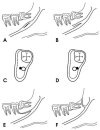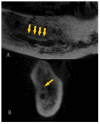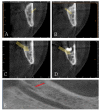Prevalence and Characteristics of Accessory Mandibular Canals: A Cone-Beam Computed Tomography Study in a European Adult Population
- PMID: 36010235
- PMCID: PMC9406331
- DOI: 10.3390/diagnostics12081885
Prevalence and Characteristics of Accessory Mandibular Canals: A Cone-Beam Computed Tomography Study in a European Adult Population
Abstract
The purpose of this observational study is to evaluate the prevalence and main characteristics of bifid canals within a European adult population, analyzing cone-beam-computed tomography (CBCT). The population study examined 300 subjects. The CBCTs were performed between 2012 and 2019, using PaX-Zenith3D with a standard protocol of acquisition. The parameters analyzed were the presence and lengths of the bifid mandibular canals. The sample included 49% male and 51% female participants. The mean age of the patients was 47.07 ± 17.7 years. Anatomical variants of the mandibular canal were identified in 28.8% of the sides and 50.3% of the patients. In 7.3% of the subjects, the anatomical variants were present bilaterally. The most frequently encountered bifid canal was Type 3 (40.5%), followed by the Type 1 canal (39.3%), the Type 2 canal (14.5%), and the Type 4 canal (5.9%), 40% on the right side and 60% on the left side. The average length of the bifid canals located on the right side of the mandible was 11.96 ± 5.57 mm, compared to 11.38 ± 4.89 mm for those measured on the left side. The bifid mandibular canal is a common anatomical variation of the mandibular canal. It is fundamental to performing an accurate preoperative evaluation using CBCT analysis to avoid and/or reduce intraoperative and postoperative complications.
Keywords: accessory mandibular foramina; bifid canals; inferior alveolar nerve; mandibular canal variant.
Conflict of interest statement
The authors declare no conflict of interest.
Figures









References
-
- Manchisi M., Bianchi I., Bernardi S., Varvara G., Pinchi V. Maxillary sinusitis caused by retained dental impression material: An unusual case report and literature review. Niger. J. Clin. Pract. 2022;25:379–385. - PubMed
LinkOut - more resources
Full Text Sources

